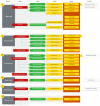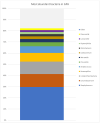Nasal Microbiome in Granulomatosis with Polyangiitis Compared to Chronic Rhinosinusitis
- PMID: 39125549
- PMCID: PMC11311696
- DOI: 10.3390/diagnostics14151673
Nasal Microbiome in Granulomatosis with Polyangiitis Compared to Chronic Rhinosinusitis
Abstract
Rhinosinusitis in granulomatosis with polyangiitis (GPA) is categorised as a secondary, diffuse and inflammatory chronic rhinosinusitis (CRS). It is one of the conditions that impacts the nasal microbiota. This study aimed to compare the nasal microbiomes of patients with GPA, CRS and NSP. A total of 31 patients were included in the study (18 GPA, 6 CRS and 7 nasal septum perforation (NSP)). In all patients, SNOT 22, a nasal endoscopy (Lund-Kennedy scale) and a brush swab were performed. The metagenomic analysis was carried out based on the hypervariable V3-V4 region of the 16S rRNA gene. At the genus level, statistically significant differences were observed in two comparisons: the GPA/NSP and the GPA/CRS groups. In the GPA/NSP group, the differences were related to four genera (Actinomyces, Streptococcus, Methylobacterium-Methylorubrum, Paracoccus), while in the GPA/CRS group, they were related to six (Kocuria, Rothia, Cutibacterium, Streptococcus, Methylobacterium-Methylorubrum, Tepidimonas). Patients with GPA had lower diversity compared to CRS and NSP patients. There were no statistically significant differences found for the Staphylococcus family and Staphylococcus aureus between the three groups.
Keywords: chronic rhinosinusitis; granulomatosis with polyangiitis; microbiome; nasal septal perforation.
Conflict of interest statement
The authors declare no conflicts of interest.
Figures







References
LinkOut - more resources
Full Text Sources

